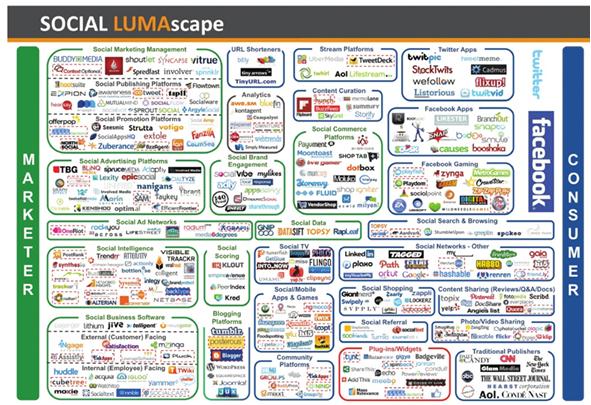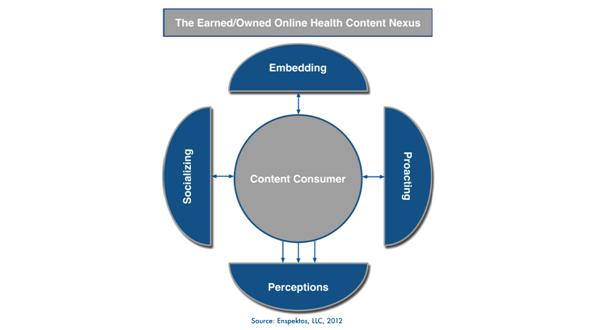The back to basics series: part 1 – how health content finds people online

Fard Johnmar
Enspektos, LLC
It’s enough to drive you crazy.
What is it? Digital!
Don’t believe me? Take a look at the graphic developed by the investment banking firm, Luma Partners. It provides a snapshot of some of the many web properties and businesses related to social media that have sprung up over the past few years. This illustration made the digital rounds in mid-May and had many people astounded at the sheer breadth of technologies and companies in the social arena.
 Luma Partners’ graphic is a lot to take in, so take a moment to review it.1
Luma Partners’ graphic is a lot to take in, so take a moment to review it.1
So, is your mind reeling as you try to decipher Luma’s work of digital art? If so, it’s clear to you that a technology-first approach to digital and social is doomed to failure. It’s almost impossible to keep track of every new technology and company. Luma even admits as much. Yet, in digital health we tend to focus on technology. How many times have you heard the following?
• You need to get with mobile,
• You need a Facebook strategy,
• Twitter is a fantastic way to deliver short, impactful health messages,
• The mobile web is dead, long live apps! (Or vice-versa)
Guess what? Technology doesn’t matter. People do. Yes, living, breathing, thinking humans are the most important force in the digital health world. If you have a people-first approach, all of a sudden keeping track of the latest technologies is a breeze. You just have to ask one question: what are the people I care about using? Find out and then focus on the technologies that matter most.
 ,
"A technology-first approach to digital and social is doomed to failure."
 ,
This people-first perspective drives our work in the digital health arena. It also will animate a series of articles I will be developing for pharmaphorum titled, “Back to basics.” The series is designed to help harried pharma and health marketers develop a fundamental understanding of the human forces driving the digital health world. In the first instalment of this series, I will focus on a very basic question: just how does health content find people online?
Digital health content’s difficult journey upstream
We all know the data. In the U.S., the majority of Internet users turn to the web to find health information. Social media channels such as Facebook and Twitter are gaining in importance. Blah, blah, blah . . . yawn. What do these statistics mean to people who are trying to leverage these technologies to deliver health information? Not much, aside from convincing them they are important.
Here are some questions pharma and health marketers should be asking about digital health:
• What are the odds that the content I produce will reach the audiences I care about via various online and social media channels?
• How can I improve my odds of reaching them?
Answering these questions requires – you guessed it – a focus on people and what they actually do when consuming earned or owned digital health content. Like the salmon struggling upstream, any information you produce must overcome many barriers before reaching its intended targets.
 ,
"Guess what? Technology doesn’t matter. People do. Yes, living, breathing, thinking humans are the most important force in the digital health world."
 ,
Over the past few years, we’ve conducted in-depth research on how content finds health providers, patients, caregivers and others online. To describe how this works, we developed a model called the “Earned / Owned Online Health Content Nexus (an illustration of the nexus appears below).

As described in the graphic, there are three primary ways online health content reaches people:
• Proacting: This involves the use of search, e-mail and other tools to actively seek out health information. Proacting is what organizations like the Pew Internet and American Life Project describe when they report that 65% of women and 53% of men look for health content online.
• Socializing: This involves receiving health information posted on social sites such as Facebook and Twitter. Now, it’s well-known that the majority of people utilizing social channels are simply consuming content. They are not creating. So, many times, socializing involves passively receiving health content delivered via a variety of social channels. Interestingly, in some cases, we’ve found that old-school journalists and other traditional media are delivering or influencing the majority of this content. Think about what that means for a second.
• Embedding: For me, this is the most fascinating aspect of how online health content reaches people. Embedding refers to how topical content is embedded into a broader health or non-health context. Embedding can take many forms, from a prevention message inserted into an online article about a celebrity benefit, to a data point on breast cancer incidence included in a news story on another subject.
You’ll notice that the final part of the nexus refers to perceptions. Remember, only when content is encountered via proacting, socializing or embedding does it have the opportunity to shape perceptions and ultimately influence behavior.
 ,
"...only when content is encountered via proacting, socializing or embedding does it have the opportunity to shape perceptions and ultimately influence behavior."
 ,
So, here are two exercises you can engage in from now until we meet again via the next installment of this pharmaphorum series:
• Exercise 1: Whenever anyone says that you MUST embrace the latest social or digital technology ask them (or yourself):
o Are the people I care about using this technology? If I don’t know, how can I find out?
o If they are using the technology, why?
• Exercise 2: Take 30 minutes to examine the online health content consumed by you or others. Then:
o Each time you encounter this information ask yourself whether it arrived via socializing, embedding, proacting or a combination of all methods
o Jot down some preliminary ideas on how you may be able to increase the odds people you care about encounter your content
Thanks for spending time with me today. Until next time, remember, people first.
References
1. The “Digital Capital LUMAscape” graphic was created by Terence Kawaja at Luma Partners. To view this graphic and see more, visit http://www.slideshare.net/tkawaja/social-lumascape-8223008
Part 2 of Fard Johnmar's "Back to basics" series will be published next month.
About the author:
Fard Johnmar is founder and president of Enspektos, LLC, an innovation consultancy that has provided digital marketing and communications services to health organizations since 2005. The firm produces technology-driven strategy, research and training products and services for a diverse range of clients, including pharmaceutical firms, government agencies, non-profits and payers.
Insights on the people-first digital health marketing strategies outlined in this article are powered by enmoebius. This is a patent pending digital surveillance and behavioral measurement engine developed by Enspektos. enmoebius drives understanding of how digital health content shapes perceptions, attitudes and behavior.
In what ways can pharma and health marketers improve their digital strategies?




